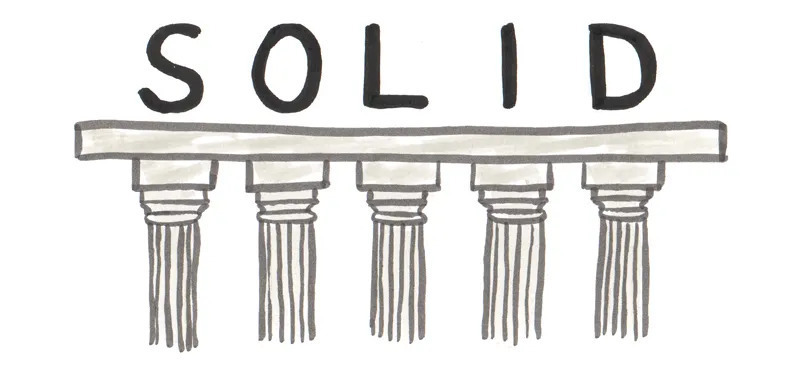SOLID 原則 - 使用 Python 中的真實範例進行解釋
- 王林原創
- 2024-09-03 11:39:29749瀏覽

堅實的原則(圖片來源:FreeCodeCamp)
SOLID 是一個縮寫詞,代表五項設計原則,可幫助開發人員創建更易於維護、更易於理解和更靈活的軟體。讓我們用一個相關的例子來逐一介紹。
1. S - 單一責任原則 (SRP)
定義:一個類別應該只有一個改變的理由,這意味著它應該只有一項工作或職責。
說明:假設您有一個工具結合了兩種不同的任務,例如發送電子郵件和處理付款。如果這兩個任務都由一個類別處理,則電子郵件功能的變更可能會破壞付款功能。將這些職責分開,您可以最大限度地減少某一部分的變化影響另一部分的風險。
範例:
class EmailSender:
def send_email(self, recipient, subject, body):
# Code to send an email
print(f"Sending email to {recipient} with subject '{subject}'")
class PaymentProcessor:
def process_payment(self, amount):
# Code to process payment
print(f"Processing payment of amount {amount}")
# Usage
email_sender = EmailSender()
email_sender.send_email("user@example.com", "Hello!", "Welcome to our service!")
payment_processor = PaymentProcessor()
payment_processor.process_payment(100)
在此範例中,EmailSender 僅負責發送電子郵件,而 PaymentProcessor 僅負責處理付款。他們每個人都有一個職責,使程式碼更容易維護和擴展。
2. O - 開閉原理 (OCP)
定義:軟體實體(如類別、模組、函數等)應該對擴充開放,但對修改關閉。
解釋:這意味著您應該能夠為類別添加新功能或行為,而無需更改其現有程式碼。假設您有一個支付處理系統,並且您想要新增一種新的支付方式。您應該能夠在不修改現有程式碼的情況下新增這個新方法。
範例:
from abc import ABC, abstractmethod
class PaymentProcessor(ABC):
@abstractmethod
def process_payment(self, amount):
pass
class CreditCardPayment(PaymentProcessor):
def process_payment(self, amount):
print(f"Processing credit card payment of {amount}")
class PayPalPayment(PaymentProcessor):
def process_payment(self, amount):
print(f"Processing PayPal payment of {amount}")
# Usage
payments = [CreditCardPayment(), PayPalPayment()]
for payment in payments:
payment.process_payment(100)
在此範例中,PaymentProcessor 是一個抽象類,它定義了用於處理付款的合約。 CreditCardPayment 和 PayPalPayment 是擴展此類的實作。如果您想新增新的付款方式,您可以建立一個擴展 PaymentProcessor 的新類,而無需修改現有類。
3. L - 里氏替換原理 (LSP)
定義:子類型必須可以取代其基本型,而不改變程式的正確性。
解釋:這表示超類別的物件應該可以用子類別的物件替換,而不會影響程式的功能。例如,如果您有一個適用於 Vehicle 類別的函數,那麼它也應該適用於任何子類,例如 Car 或 Bike。
範例:
class Vehicle:
def start_engine(self):
pass
class Car(Vehicle):
def start_engine(self):
print("Starting car engine...")
class Bike(Vehicle):
def start_engine(self):
print("Starting bike engine...")
# Usage
def start_vehicle_engine(vehicle: Vehicle):
vehicle.start_engine()
car = Car()
bike = Bike()
start_vehicle_engine(car) # Should work fine
start_vehicle_engine(bike) # Should work fine
在此範例中,Car 和 Bike 是 Vehicle 的子類別。 start_vehicle_engine 函數可以與 Vehicle 的任何子類別一起工作,而不需要知道子類別的具體情況,這符合里氏替換原則。
4. I - 介面隔離原則 (ISP)
定義:客戶端不應該被迫實作它不使用的介面。與一個胖接口不同,許多基於方法組的小接口是首選,每個方法服務一個子模組。
說明:這項原則建議您應該為每種類型的客戶端創建特定的接口,而不是一個通用的接口。想像一下您有一台可以列印、掃描和傳真的機器。如果您有單獨的機器只能列印或掃描,則不應強迫它們實現不使用的功能。
範例:
from abc import ABC, abstractmethod
class Printer(ABC):
@abstractmethod
def print(self, document):
pass
class Scanner(ABC):
@abstractmethod
def scan(self, document):
pass
class MultiFunctionDevice(Printer, Scanner):
def print(self, document):
print(f"Printing: {document}")
def scan(self, document):
print(f"Scanning: {document}")
# Usage
mfd = MultiFunctionDevice()
mfd.print("Document 1")
mfd.scan("Document 2")
這裡,印表機和掃描器是獨立的介面。 MultiFunctionDevice 實現了兩者,但如果存在僅列印或僅掃描的設備,則它們不需要實作不使用的方法,遵循介面隔離原則。
5. D - 依賴倒置原則(DIP)
定義:高層模組不應該依賴低層模組。兩者都應該依賴抽象(例如介面)。抽像不應該依賴細節。細節應該取決於抽象。
說明:高階類別不應直接依賴低階類,而應依賴介面或抽象類別。這允許更大的靈活性和更容易的維護。
範例:
from abc import ABC, abstractmethod
class NotificationService(ABC):
@abstractmethod
def send(self, message):
pass
class EmailNotificationService(NotificationService):
def send(self, message):
print(f"Sending email: {message}")
class SMSNotificationService(NotificationService):
def send(self, message):
print(f"Sending SMS: {message}")
class NotificationSender:
def __init__(self, service: NotificationService):
self.service = service
def notify(self, message):
self.service.send(message)
# Usage
email_service = EmailNotificationService()
sms_service = SMSNotificationService()
notifier = NotificationSender(email_service)
notifier.notify("Hello via Email")
notifier = NotificationSender(sms_service)
notifier.notify("Hello via SMS")
在此範例中,NotificationSender 依賴NotificationService 抽象,而不是依賴像EmailNotificationService 或SMSNotificationService 這樣的特定類別。這樣,您就可以在不更改NotificationSender類別的情況下切換通知服務。
結論
單一職責原則(SRP):一個類別應該做一件事,並且把它做好。
開閉原則(OCP):類別應該對擴展開放,但對修改關閉。
里氏替換原則(LSP):子類別應該可以取代它們的基底類別。
介面隔離原則 (ISP):任何客戶端都不應被迫依賴它不使用的方法。
依賴倒置原則(DIP):依賴抽象,而不是具體實現。
遵循這些 SOLID 原則,您可以建立更易於理解、維護和擴充的軟體。
以上是SOLID 原則 - 使用 Python 中的真實範例進行解釋的詳細內容。更多資訊請關注PHP中文網其他相關文章!

